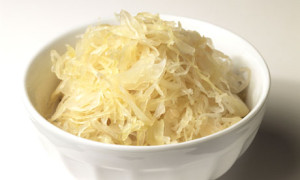My dad, who is of dutch heritage, made me eat a lot of stuff growing up that his mom made for him. I still like speculaas cookies, but zuurkool, a dish made with sauerkraut and potatoes was not something I was into. 
Sauerkraut just isn’t my favorite; I find the taste too, uh, sour. The cabbage-based fermented dish is made by adding shredded cabbage leaves into a salted brine and placing the mixture into a cool space and letting bacteria do their thing. There’s a lot of science involved in the process (check out the history of pickling and vegetable fermentation that my friend Fred Breidt and his colleagues have pulled together).
According to a Boston Globe, there’s increased interest in a new business focusing on teaching people how to do things themselves, homesteader-style. The skills include fermentation, cheese making and bike fixing,
With its handmade book shelves and salvaged tables, The Haberdashery is an exhibition of creative recycling. Inventory mostly consists of the tools and materials for the modern-day homesteader such as cheesemaking kits, shears, knives, live cultures, handmade aprons. Litwin will eventually expand the supply stock. Classes reflect equal variety and can, if the need arises, be paid for in barter. Some courses currently on the schedule include sausage-making, herb and fruit-infused soda making, preserves, and home canning. There is a DIY-themed library available for in-house and books for sale.
In a recent Fermentation 101 class, Melody Litwin is helping a group of students transform a head of cabbage into crunchy sauerkraut. After chopping, salting, and vigorously massaging the vegetable like a Japanese Wagyu cow, the cabbage is stuffed into large Mason jars and left to spawn bacteria — the good kind.
“Don’t worry,” says Litwin, addressing a collective concern for food safety. “This process creates an environment that is beneficial for good organisms. The lactic acid produced supports lactobacillus, a kind of bacteria we actually want to eat.” She adds, “The rule of thumb is: If it smells fine, it’s fine.”
I’d rather folks follow a recipe that has some data behind it instead of using a sniff test, like what the National Center for Home Food Preservation produces. See their
sauerkraut procedures here. And that the end product is either refrigerated or heat-treated to address any of the acid tolerant pathogens that might be in a DIY bike/canning/cheese shop that could contaminate post-fermentation.

